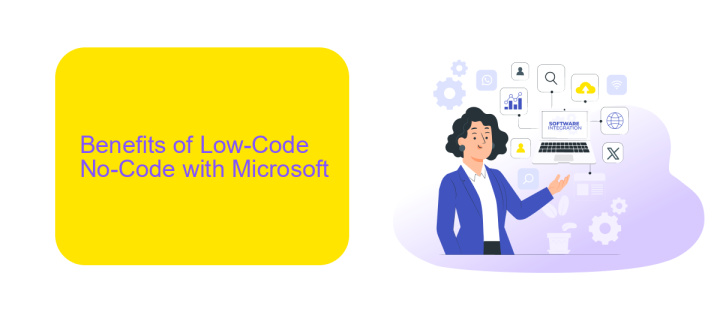Low-Code No-Code Microsoft
In today's rapidly evolving digital landscape, businesses are increasingly turning to low-code and no-code platforms to accelerate their development processes. Microsoft, a leader in enterprise solutions, offers robust tools that empower organizations to build applications with minimal coding expertise. This article explores Microsoft's low-code and no-code offerings, highlighting their benefits, features, and impact on modern business operations.
Introduction
The rise of low-code and no-code platforms has revolutionized the way organizations develop applications, making it easier for individuals with little to no programming experience to create functional software. Microsoft has emerged as a key player in this domain, offering a suite of tools that empower users to build, customize, and deploy applications rapidly.
- Microsoft Power Apps: Enables users to create custom apps with minimal coding.
- Microsoft Power Automate: Automates workflows between various applications and services.
- Microsoft Power BI: Provides powerful data visualization and business analytics capabilities.
These tools not only streamline the development process but also facilitate seamless integration with other services. For instance, ApiX-Drive offers a robust solution for integrating various applications and automating workflows, complementing Microsoft's low-code/no-code ecosystem. By leveraging such integrations, businesses can enhance their operational efficiency and accelerate digital transformation.
Benefits of Low-Code No-Code with Microsoft

Low-code and no-code platforms provided by Microsoft, such as Power Apps and Power Automate, offer significant benefits for businesses. These tools enable users with little to no programming experience to create applications and automate workflows rapidly. This accelerates the development process, reduces costs, and allows for quicker iteration and deployment. Additionally, by empowering non-developers to build solutions, organizations can alleviate the burden on IT departments and encourage innovation across various teams.
Another key advantage is the seamless integration capabilities with other Microsoft services like Azure, Dynamics 365, and Office 365. These integrations ensure that applications and workflows can easily connect with existing systems, enhancing productivity and data consistency. For more complex integrations, services like ApiX-Drive can be utilized to connect various applications and automate data transfers without the need for extensive coding. This flexibility and ease of use make low-code and no-code solutions from Microsoft a valuable asset for modern businesses looking to stay agile and competitive.
Microsoft Low-Code No-Code Platform

Microsoft's Low-Code No-Code platform empowers users to build applications with minimal coding knowledge. This approach democratizes app development, allowing business users and professionals to create custom solutions tailored to their specific needs. The platform integrates seamlessly with various Microsoft services, making it a versatile tool for modern enterprises.
- Power Apps: Create custom apps quickly with a drag-and-drop interface.
- Power Automate: Automate workflows and business processes effortlessly.
- Power BI: Generate insightful reports and dashboards with ease.
- Dataverse: Store and manage data securely within your applications.
Additionally, integrating third-party services such as ApiX-Drive can further enhance the capabilities of your applications. ApiX-Drive allows for smooth integration with various external systems, enabling seamless data flow and synchronization. This ensures that your low-code, no-code solutions remain flexible and adaptable to changing business requirements.
Top Use Cases for Low-Code No-Code Microsoft

Low-Code No-Code platforms by Microsoft have revolutionized the way businesses operate by enabling rapid application development with minimal coding skills. These platforms empower both professional developers and business users to create custom solutions that address specific organizational needs.
One of the primary use cases for Low-Code No-Code Microsoft solutions is automating repetitive tasks. Businesses can leverage tools like Power Automate to streamline workflows, reducing manual effort and increasing efficiency.
- Automating repetitive tasks using Power Automate
- Creating custom business applications with Power Apps
- Building interactive data visualizations through Power BI
- Setting up seamless integrations with third-party services using ApiX-Drive
Another significant use case is data visualization and analysis. With Power BI, users can transform raw data into insightful reports and dashboards, facilitating data-driven decision-making. Additionally, integrating various services and applications is made easier with tools like ApiX-Drive, which simplifies the process of connecting disparate systems.


Future of Low-Code No-Code Microsoft
The future of Low-Code No-Code (LCNC) platforms at Microsoft looks promising as the demand for rapid application development continues to rise. With tools like Power Apps and Power Automate, Microsoft is empowering both developers and non-developers to create sophisticated applications and workflows with minimal coding. These platforms are continually evolving, integrating advanced AI capabilities and expanding their functionality to meet the growing needs of businesses. As organizations strive for digital transformation, the importance of LCNC solutions will only increase, making it easier for teams to innovate and adapt quickly.
Integration capabilities will play a crucial role in the future of LCNC platforms. Services like ApiX-Drive are becoming essential as they enable seamless integration between various applications and services. By using ApiX-Drive, users can effortlessly connect their Microsoft LCNC solutions with other tools, ensuring a smooth data flow and enhancing overall productivity. As Microsoft continues to develop its LCNC offerings, we can expect to see more robust integration features and partnerships, further solidifying its position as a leader in the LCNC space.
FAQ
What is Low-Code/No-Code development?
How does Low-Code/No-Code benefit businesses?
Can I integrate Low-Code/No-Code applications with other systems?
Is Low-Code/No-Code suitable for complex enterprise applications?
What skills are needed to use Low-Code/No-Code platforms?
Time is the most valuable resource in today's business realities. By eliminating the routine from work processes, you will get more opportunities to implement the most daring plans and ideas. Choose – you can continue to waste time, money and nerves on inefficient solutions, or you can use ApiX-Drive, automating work processes and achieving results with minimal investment of money, effort and human resources.

